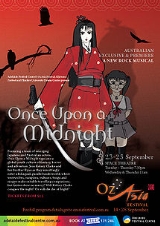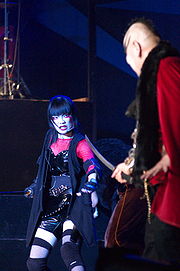
Once Upon a Midnight
Encyclopedia
Production history
Once Upon a Midnight is a Japanese/Australian rock musical. The script is bilingual, featuring seven Japanese performers and seven Australian performers. It follows the adventures of Kelsey Clarke and the warrior doll Nozomi as they journey to the Underground to liberate the monster world from the mysterious Angelica.The show was first performed at the Kijimuna Festival
Kijimuna Festival
The Kijimuna Festival is a yearly children's theatrical festival in Okinawa, Japan. It is sponsored by the city of Okinawa and features content from around the world...
in Okinawa, Japan, and later appeared as a headline act at the OzAsia Festival in Adelaide
Adelaide
Adelaide is the capital city of South Australia and the fifth-largest city in Australia. Adelaide has an estimated population of more than 1.2 million...
, South Australia. It was a collaboration between the Kijimuna Festival, Flinders University Drama Centre and Adelaide Festival Centre.
Synopsis
Kelsey Clarke is very afraid. She is afraid of germs, she is afraid of traffic…even the toaster makes her feel very afraid.Deep in the Underground, the monsters are afraid too. Angelica, the Blue Fairy, has flown into their world. No longer will the monsters be allowed to terrify unsuspecting children, no longer can they drink blood and dance the night away.
Powerless to confront Angelica, the Tengu — Lord of the Underground — has no choice but to find the world’s most frightened child and teach her to confront her fear. For timid Kelsey, this means putting on her best cardigan and plunging headlong into the monster kingdom — from murky swamps to haunted Ghost Roads!
With an enchanted doll and a vegetarian vampire to guide her, Kelsey touches her darker side. But is becoming her own nightmare any better than cowering alone under blankets? Can Kelsey summon the courage to find her true self, face her demons and stand against the magical Angelica? Or will the sun rise forever on a future where only the fearful survive?
Intercultural Significance
Director Catherine Fitzgerald claimed in Rip It Up magazine that Once Upon a Midnight has a metaphorical base
"It works on many levels. Is it about a young kid with fear who gets kidnapped by monsters? Or is it something else? Is it about the war on terror? There are a lot of things layered into the story."
The show was written in equal parts English and Japanese, with Australian playwright Alex Vickery-Howe working closely with Japanese translator Ken Yamamura. The combination of languages posed interesting challenges. Quoted in Lowdown Magazine, Yamamura said
"... the sense of humour is completely different and also the words we use [in English] for the humour [is completely different]. So I translated literally with description and [the Japanese cast] still didn't find it funny so I had to come up with something equivalent to that joke to find the Japanese understanding."
Vickery-Howe added
"Sarcasm is lost. I offended a lot of people just being myself... it's that Australian thing of saying 'I hate you' but really meaning 'I like you' which is taken literally."
Journalist Ursula Beaumont goes on to note that
"Targeting teenage audiences with an experience that introduces 'the other' in a fun, positive, familiar way with the monsters crossing the cultural divide, is a refreshing approach to gaining understanding of another culture. What's more, it's a young bi-cultural cast strutting their stuff, making the production a unique work..."
Speaking to the Helpmann Academy
Helpmann Academy
The Helpmann Academy was formed in 1994 as a partnership of the major tertiary arts training institutions in South Australia.It brings together the skills and resources of South Australia's universities and TAFE SA, with courses in music, dance, drama, directing, visual arts, technical theatre...
's Arts Magazine actor Matthew Crook reflected on the experience of working interculturally
"Performing Once Upon a Midnight in Japan has been an overwhelming experience and certainly unforgettable. No matter how much or how little we spoke each other's language, I found there was always an indescribable connection."
Critical reception

In his enthusiastic review for Rip It Up, Barry Lenny praised Mai Kakimoto for her "standout performance" as Nozomi and described the show as both "superb" and "a high energy, fast-paced work that captures the imagination" noting "influences of Noh
Noh
, or - derived from the Sino-Japanese word for "skill" or "talent" - is a major form of classical Japanese musical drama that has been performed since the 14th century. Many characters are masked, with men playing male and female roles. Traditionally, a Noh "performance day" lasts all day and...
, Kabuki
Kabuki
is classical Japanese dance-drama. Kabuki theatre is known for the stylization of its drama and for the elaborate make-up worn by some of its performers.The individual kanji characters, from left to right, mean sing , dance , and skill...
, Butoh
Butoh
is the collective name for a diverse range of activities, techniques and motivations for dance, performance, or movement inspired by the movement. It typically involves playful and grotesque imagery, taboo topics, extreme or absurd environments, and is traditionally performed in white body makeup...
and even Bunraku
Bunraku
, also known as Ningyō jōruri , is a form of traditional Japanese puppet theater, founded in Osaka in 1684.Three kinds of performers take part in a bunraku performance:* Ningyōtsukai or Ningyōzukai—puppeteers* Tayū—the chanters* Shamisen players...
in evidence."
Youth reviewer Sam Ryan said "Not only was Once Upon a
Midnight an excellent example of
cross cultural collaboration and
exchange, it was also pure fun
all the way through" while Richard Flynn for the Adelaide Theatre Guide praised the use of both Japanese and English in the text, saying "they have no need of surtitles! All is clear enough, and very clever!", adding "Will Kelsey Clarke conquer the night, her seemingly boundless fears of germs, her big brother, traffic, and all the people in the world who are not ‘like her’? She and her friends certainly conquered one Adelaide Opening Night audience!"
Reviews and Articles
- SA Life, September 2008, "Found in Translation" by Lance Campbell
- DB Magazine, Issue 448, pg. 4 Theatre Guide, by Alex Wheaton
- Update Arts Magazine, Vol 15, No 3, Issue 61, pg. 6, "Once Upon a Midnight", by Matthew Crook
- Guardian Messenger, Sep 17 2008, pg. 48, "Rock and Scares in the Midnight Hour" by Melissa Phillips
- The Advertiser, Sept 13 2008 "Mythology of Two Cultures" by Tim Lloyd
- Adelaide Matters, Issue 102, Sept 10-Oct 7, 2008, pg. 12/13 "Cultural Ties" by Catherine Clifton and Kylie Fleming
- Rip it Up, Sept 11 2008, "Once Upon a Midnight", by Robert Dunstan
- The Journal of The Asian Arts Society of Australia Vol 18, No 2, June 2009, pg.20/21 by Alex Vickery-Howe
Song List
Bring on the Night:Yoshiki, Scratch, Kango, Tweetles and the Vultures
Frightened of the World:
Kelsey
Dance, Monster, Dance:
Kango
Into the Dark:
Nozomi, Scratch, Kelsey, Yoshiki, Ryan, Leiko, Tweetles and the Vultures
Hot Red Sugar:
Damon, Zombies
Taming of the Wolf:
Scratch, Angelica
Make Believe:
Kelsey, Damon, Shima, Ryan, Yoshiki, Nozomi, Tweetles and the Vultures
Close Your Eyes:
Angelica
The Night is Ours Again:
Company
Monsters of the Underground
Nozomi, the NingyōJapanese traditional dolls
Japanese traditional dolls are known by the name in Japan, which literally means human shape.There are various types of Japanese dolls, some representing children and babies, some the imperial court, warriors and heroes, fairy-tale characters, gods and demons, and also people of the daily life of...
: Mai Kakimoto
Angelica, the Blue Fairy
Blue Fairy
The Fairy With Turquoise Hair is a fictional character in Carlo Collodi's book The Adventures of Pinocchio. She repeatedly appears at critical moments in Pinocchio's wanderings to admonish the little wooden puppet to avoid bad or risky behavior...
: Michelle Pastor
Shima, the Kijimuna
Kijimuna
The Kijimuna are creatures of Japanese mythology native to the island of Okinawa. They are said to look around three or four years old and covered in red hair.- About :...
: Shusaku Uchida
Yoshiki, the Tengu
Tengu
are a class of supernatural creatures found in Japanese folklore, art, theater, and literature. They are one of the best known yōkai and are sometimes worshipped as Shinto kami...
: Tenchou
Kango, the Kappa
Kappa
Kappa is the 10th letter of the Greek alphabet, used to represent the voiceless velar stop, or "k", sound in Ancient and Modern Greek. In the system of Greek numerals it has a value of 20. It was derived from the Phoenician letter Kaph...
: Shimabukuro Hiroyuki
Damon, the Vampire
Vampire
Vampires are mythological or folkloric beings who subsist by feeding on the life essence of living creatures, regardless of whether they are undead or a living person...
: David Hirst
Scratch, the Werewolf
Werewolf
A werewolf, also known as a lycanthrope , is a mythological or folkloric human with the ability to shapeshift into a wolf or an anthropomorphic wolf-like creature, either purposely or after being placed under a curse...
: Chris Asimos
People of Earth
Kelsey, a fourteen-year-old girl: Lauren HendersonRyan, her brother, sixteen: Matthew Crook
Leiko, a toddler: Keiichi Yonamine
The Vultures
Tweetles: Melissa MathesonFlopsy: David Hirst
Bedlam: Michelle Pastor
Kowashimashou: Shusaku Uchida
Zuru-Zuru: Keiko Yamaguchi
Hiyokko: Ken Yamamura
Production credits
Director: Catherine FitzgeraldChoreography: Yumi Umiumare
Assistant Director: Momoko Iwaki
Costume Design: Oka Kazuyo
Dramaturg: Julie Holledge
Set Design: Naomi Steel
Design consultant: Mary Moore
Stills Photographer: Tomoaki Kudaka
Music consultant: Stuart Day
Sword Fight Choreographer: Tuyoshi China
Lighting Designer (Japan): Yoshimi Sakamoto
Lighting Designer (Australia): Fred Schultz
Stage Manager (Australia): Maj Green
Production Manager (Australia): Andrew Bailey
Set Construction (Australia): Glen Finch
Book Translation (to Japanese): Ken Yamamura with Yumi Umiumare
Lyrics Translation (to Japanese): Ken Yamamura, Yumi Umiumare, Keiko Yamaguchi, and Mai Kakimoto
Produced by Hisashi Shimoyama, Artistic Director of the Kijimuna Festival, and
Professor Julie Holledge, Flinders University Drama Centre.

